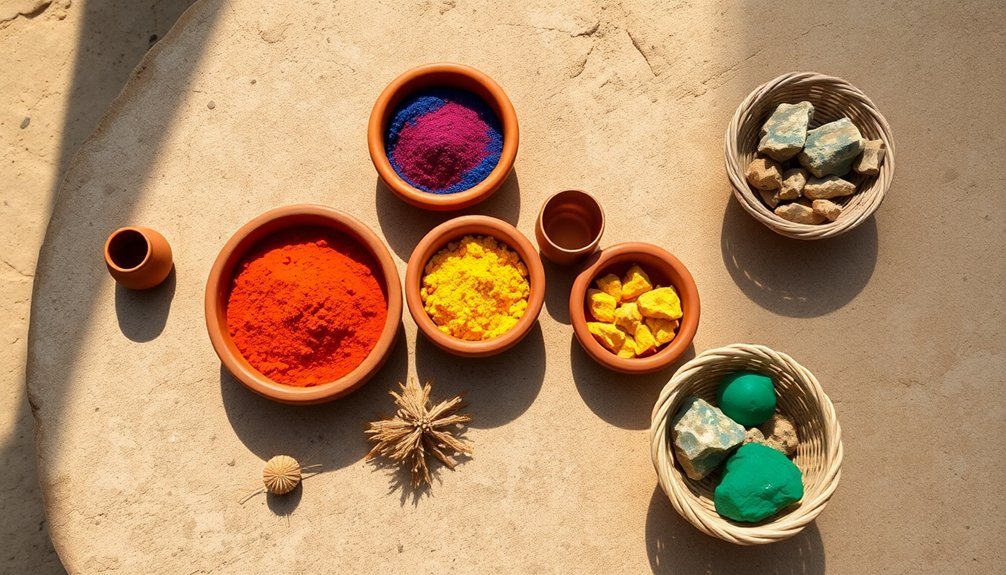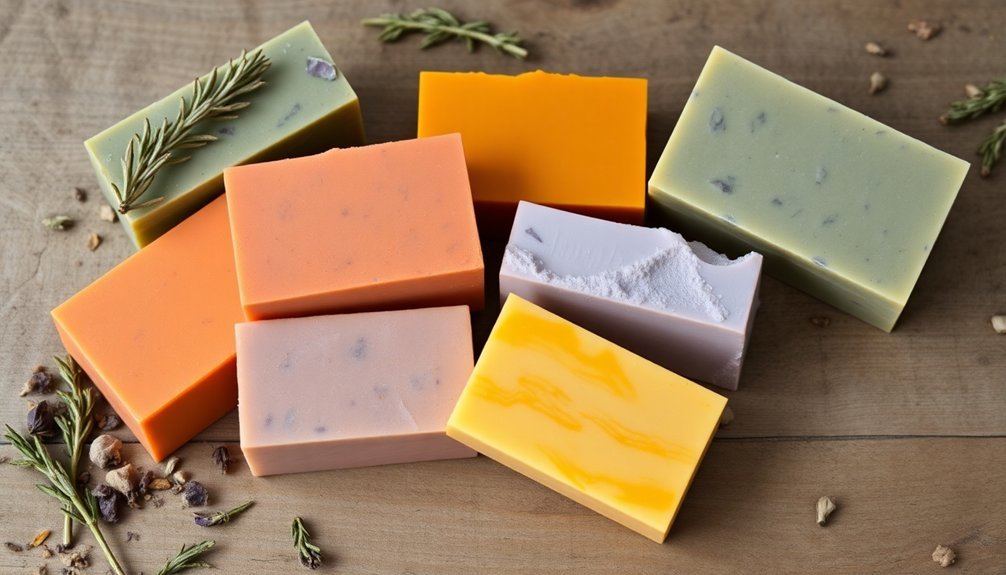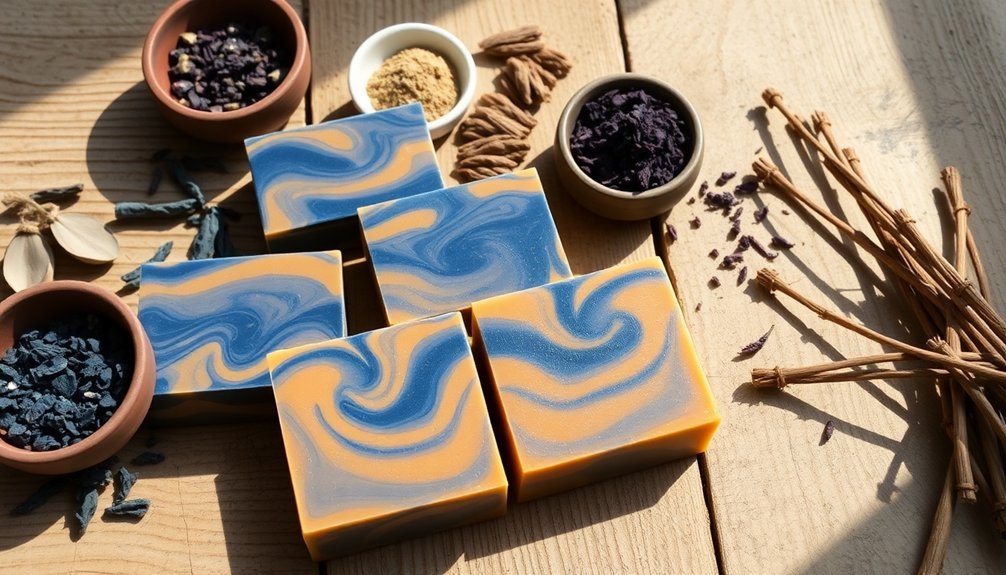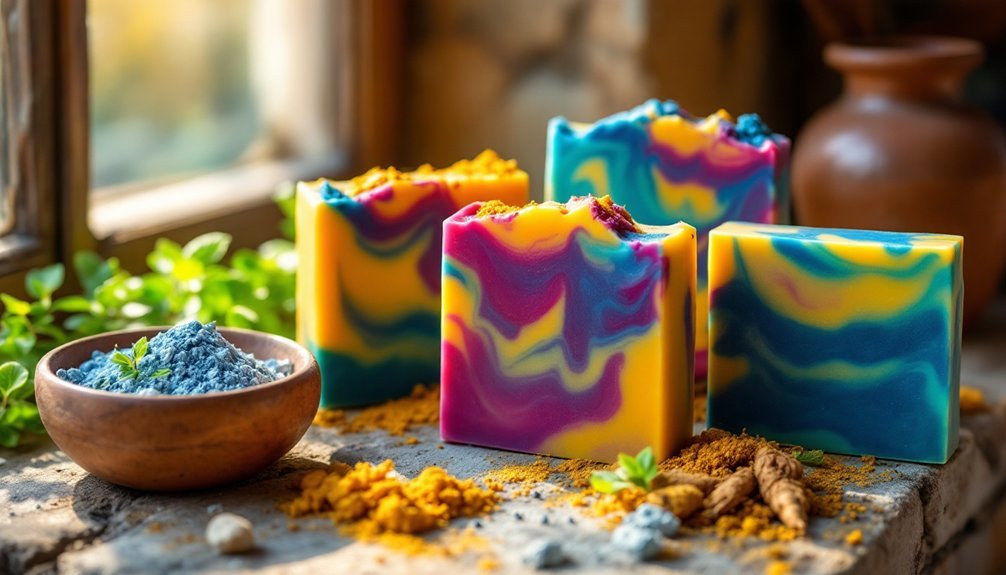Ancient cultures colored their soaps with an impressive array of natural materials you'd find fascinating. They used plant-based dyes like indigo for blue, madder root for red, and saffron for yellow-orange hues. You'll also find they incorporated minerals such as ochre and malachite, plus local herbs and flowers specific to their regions. The rich traditions of natural soap coloring span from Mesopotamia to Asia, with each culture developing unique techniques that still inspire today.
Natural Plant Dyes in Early Mesopotamian Soap Making

While many ancient civilizations developed soap-making techniques, the Mesopotamians stood out for their innovative use of natural plant dyes.
You'll find that ancient Mesopotamians cleverly incorporated three main plant sources to enhance their soap's visual appeal: indigo, madder root, and saffron.
When you examine their cultural practices, you'll see how they utilized the indigo plant to create striking blue hues, while madder root from the Rubia tinctorum plant provided rich red tones.
Saffron, being particularly precious, added luxurious yellow-orange colors to their soap making process.
These natural plant dyes weren't just about aesthetics – they represented the region's sophisticated trade networks and deep understanding of local resources.
Ancient Mesopotamian plant dyes showcased both their mastery of regional resources and their far-reaching trade connections across civilizations.
The Mesopotamians' careful selection of these colorants demonstrates their advanced knowledge of both commerce and craftsmanship in soap production.
Egyptian Mineral Pigments and Sacred Colorants

Similar to their Mesopotamian neighbors, ancient Egyptians mastered the art of soap coloring, though they favored mineral-based pigments over plant dyes.
You'll find they relied heavily on mineral pigments like ochre, malachite, and azurite to create soaps in earthy, green, and blue hues. These weren't just for aesthetic appeal – the colors held deep cultural significance, often linked to specific deities and religious ceremonies.
When coloring soaps, ancient Egyptians would carefully grind these mineral pigments and combine them with oils and alkaline materials.
They'd also incorporate sacred plant-based dyes for special religious rituals. The importance of colored soap in Egyptian society is well-documented in artifacts like the Ebers Papyrus, showing how they valued these colorful cleansing products for both hygiene and spiritual practices.
Mediterranean Herb-Based Soap Colors

Unlike their Egyptian counterparts who favored minerals, Mediterranean soap makers turned to the region's abundant herbs and plants for their colorants.
You'll find they created vibrant soaps by infusing olive oil with natural colorants derived from local flora. The result was a stunning array of hues that served both practical and aesthetic purposes.
Mediterranean artisans utilized indigo for blue shades and madder root to achieve rich reds. They'd often incorporate prestigious saffron for its luxurious yellow tones, while ground spices like turmeric and paprika added warm colors and skin-nourishing properties.
These choices weren't just about appearance – they reflected the cultural significance of herbs and plants in Mediterranean society. Each colorant told a story of the region's deep connection to its natural resources and traditional practices.
Celtic and Germanic Plant-Based Dyeing Methods

Through centuries of experimentation, Celtic and Germanic soap makers developed sophisticated plant-based dyeing methods that rivaled their Mediterranean neighbors.
You'll find they expertly extracted natural colors from local flora, creating vibrant dyes for their soaps by boiling plants with fats and oils before the saponification process.
The Celtic and Germanic cultures mastered these plant-based techniques, offering:
- Red hues from madder root and blue tones from woad plants
- Yellow and orange shades using chamomile and calendula flowers
- Purple and pink colors derived from various wild berries
When you examine their methods, you'll discover they weren't just creating beautiful soaps – they were developing a thorough understanding of how different plants could contribute both color and beneficial properties to their final products.
Their innovative approach to natural dyeing continues to influence modern soap making.
Ancient Asian Botanical Color Sources

You'll find that ancient Asian cultures mastered the art of soap coloring through an impressive array of botanical sources, including turmeric for yellow and indigo leaves for deep blue hues.
Traditional Chinese herbalists carefully selected plants like safflower petals and madder root to create vibrant orange and red pigments in their soap-making processes.
The rich diversity of indigenous plant extracts, from hibiscus to beetroot, showcases how Asian civilizations developed sophisticated natural dyeing techniques that enhanced both the aesthetic and practical aspects of their soaps.
Traditional Chinese Herbal Dyes
While many ancient cultures developed methods for coloring soap, traditional Chinese soap makers mastered the art of using local botanical sources to create vibrant, meaningful hues.
Chinese cultures embraced herbal dyes not just for their visual appeal, but for their medicinal properties in traditional soap making. These botanical colorants were carefully selected from native plants, flowers, and minerals.
Three key aspects of Chinese herbal dye traditions:
- Safflower petals produced yellow tones while indigo leaves created blue hues, and madder root delivered rich reds.
- Color choices aligned with traditional Chinese medicine principles, reflecting the balance of body energies.
- Essential oils were combined with these colorants to enhance both therapeutic benefits and sensory experience.
The integration of these natural dyes demonstrated the sophisticated understanding of both aesthetics and wellness in ancient Chinese soap making.
Asian Indigenous Plant Extracts
Ancient Asian civilizations left an indelible mark on soap-making history with their mastery of indigenous plant extracts for coloring. You'll find that these cultures expertly used natural dyeing techniques to create vibrant soaps that were both beautiful and meaningful.
| Plant Source | Color | Region of Use |
|---|---|---|
| Turmeric | Yellow | India, SE Asia |
| Indigo Plant | Blue | China, Japan |
| Lacquer Tree | Red | Japan |
| Hibiscus | Pink/Red | Southeast Asia |
The range of plant extracts they used was remarkable. While turmeric provided golden hues in Indian soaps, Japanese artisans turned to the lacquer tree's sap for deep reds. You'll notice that indigo was particularly significant in East Asian soap-making, creating distinctive blue shades. Southeast Asian cultures embraced hibiscus for its pink tones, while green tea and pandan leaves contributed natural green colors to their soap-making traditions.
Native American Natural Soap Pigments
Native American tribes demonstrated remarkable ingenuity in their approach to soap coloring, drawing from the rich palette of natural resources around them. Their resourcefulness in creating natural pigments reflected their deep understanding of local plants, minerals, and even insects.
You'll find that their soaps featured colors derived from various sources, with each hue carrying cultural significance in their traditions.
The Native Americans' expertise in natural dyeing is evident through:
- Root-based colors: Madder and yellow dock roots provided rich reds and yellows
- Berry-derived hues: Elderberries and blackberries created deep purples and blues
- Mineral pigments: Ochre clay delivered earthy tones, while cochineal insects produced vibrant reds
These color choices weren't merely decorative – they represented the tribes' spiritual connection to the land and their cultural heritage.
African Traditional Soap Coloring Practices
You'll find that ancient African soap makers expertly wielded a diverse palette of natural colorants, from the deep blues of indigo to the rich reds of annatto seeds.
African communities mastered the use of regional clays and mineral pigments, often incorporating ochre and various earth-toned materials to create soaps that reflected their cultural heritage.
The practice of coloring soap was deeply communal, with different regions developing their own signature combinations of plant-based dyes, including vibrant hibiscus petals and baobab root extracts.
Traditional Plant-Based Dyes
The rich tapestry of African soap-making traditions reveals an ingenious use of plant-based dyes derived from local flora.
You'll find traditional artisans expertly extracting natural colors from ingredients like indigo plants for blue hues and annatto seeds for vibrant oranges and yellows. The African locust bean tree's bark provides deep brown shades, while henna leaves contribute rich reddish tones.
These sustainability-focused practices demonstrate three key aspects of African soap-making heritage:
- The masterful understanding of local plant properties
- The seamless integration of natural ingredients into artisanal crafts
- The cultural significance of color in traditional soap-making
You're witnessing a time-tested approach that doesn't just create beautiful soaps but also honors the deep connection between nature and craftsmanship in African cultures.
Regional Clay Coloring Methods
While plant-based dyes formed an essential part of African soap-making, regional clay varieties offered an equally important source of natural coloring. You'll find that traditional soaps incorporated these natural clays not just for their aesthetic integration but also for their beneficial properties. The practice combined regional aesthetics with therapeutic benefits that enriched both appearance and function.
| Clay Type | Primary Benefits |
|---|---|
| Red Ochre | Iron-rich exfoliation |
| Yellow Kaolin | Gentle cleansing |
| Kalahari Red | Mineral enrichment |
| Local Clays | Texture enhancement |
These coloring practices demonstrate how African artisans masterfully blended botanical extracts with various clay types. You'll see this wisdom passed through generations, where each region developed unique combinations of clays and plant materials to create distinctive soaps that were both beautiful and beneficial for the skin.
Middle Eastern Spice and Mineral Colorants
Ancient Middle Eastern civilizations mastered the art of soap coloring through their sophisticated use of natural spices and minerals. You'll find they transformed everyday soaps into vibrant works of art using readily available ingredients like saffron for rich yellows, turmeric for golden hues, and indigo for deep blues.
They also incorporated mineral colorants such as ochre and clay to achieve earthy tones and enhanced textures.
These natural colorants weren't just for aesthetics. They reflected deep cultural significance in three key ways:
- Connected daily cleansing rituals to spiritual practices
- Demonstrated social status through the use of precious ingredients like saffron
- Preserved traditional knowledge of natural dyeing techniques
The artisans' expertise in combining these ingredients showcased their understanding of color manipulation, setting standards that influenced soap-making traditions for generations to come.
Ancient Roman Soap Pigmentation Techniques
Moving westward from Middle Eastern traditions, Roman soapmakers developed their own distinct approaches to soap coloring.
Ancient Roman artisans forged new paths in soap making, breaking from Eastern methods to create uniquely Roman coloring techniques.
The ancient Romans sourced their pigments from both minerals and plants, using ochre and madder root for red colors, while indigo provided blue shades. You'll find they didn't just focus on mineral-based pigments – they also incorporated herbs and flowers like lavender and rosemary for subtle hues and fragrance.
Their saponification process was methodical, carefully blending these natural pigments with oils and fats to guarantee even color distribution.
Some ambitious Roman artisans even created layered soaps by pouring different colored mixtures in sequence.
These vibrant soaps became status symbols, with wealthy Romans favoring the most elaborate and colorful varieties, showcasing the sophisticated techniques of Roman soap craftsmanship.
Greek Natural Color Extraction Methods
The ancient Greeks mastered color extraction through their skillful use of Mediterranean plants like indigo, madder root, and saffron to create vibrant soaps in blue, red, and yellow hues.
You'll find they didn't limit themselves to flora alone, as they expertly combined mineral sources such as ochre and charcoal with crushed insects like cochineal to expand their color palette.
Their sophisticated techniques reflected both practical knowledge and cultural symbolism, as they crafted these natural pigments from readily available resources throughout the Greek territories.
Plant-Based Dye Production
While many cultures developed methods for coloring soap, Greek artisans mastered the art of extracting vibrant dyes from local plants and herbs. Their plant-based approach to natural dyes reflected their deep appreciation for aesthetics in soap production.
By boiling specific herbs and plant materials, they'd create concentrated pigments that blended seamlessly with their soap bases.
The ancient Greeks relied on three primary sources for their vibrant soap colors:
- Madder root for striking red and yellow hues
- Indigo plants for rich blue shades
- Saffron and walnut hulls for golden and brown tones
You'll find they also experimented with softer colors, using chamomile and spinach to create delicate pastels.
Their coloring techniques weren't just about appearance – they represented the Greeks' commitment to elevating everyday hygiene into an art form.
Clay and Mineral Pigments
Beyond plant-based dyes, ancient Greeks mastered another sophisticated coloring technique using minerals and clays found in their local landscapes.
They'd extract natural colorants by grinding clay and mineral pigments into fine powders, which they'd then blend into their soap formulations.
You'll find that these ancient Greeks were remarkably resourceful, sourcing materials like iron oxide for red and yellow hues, while manganese oxide provided purple tones.
Their method wasn't just about visual appeal – these natural colorants could actually affect the soap's texture and lathering qualities.
By carefully selecting and processing these mineral pigments, they created soaps that served both practical and aesthetic purposes.
This innovative approach to soap coloring demonstrates their deep understanding of natural materials and their skilled manipulation of local resources.
Mediterranean Color Extraction Techniques
Ancient Greek soapmakers developed sophisticated color extraction methods that showcased their mastery of natural materials. Their Mediterranean approach to natural colorants relied heavily on local plant materials, which they'd transform into vibrant pigments for their soap formulations.
You'll find their color extraction techniques were remarkably systematic:
- They'd boil specific flowers, leaves, and roots in water to release their natural pigments.
- They'd combine extracted dyes like madder root (red), indigo (blue), and turmeric (yellow) with their soap mixtures.
- They'd supplement plant-based colors with mineral pigments from ochre and clay.
The ancient Greeks understood that the visual appeal of their soaps mattered as much as their cleansing properties. Their expertise in harvesting and processing these natural materials demonstrated their deep understanding of the relationship between beauty and functionality in soap making.
Aztec and Mayan Soap Coloring Materials
The vibrant world of Aztec and Mayan soap making reveals a sophisticated understanding of natural dyes and their cultural significance.
You'll find they sourced their colorants from an impressive variety of plants, minerals, and insects native to their regions.
Cochineal insects provided a striking red dye when crushed, while annatto seeds from the achiote tree delivered warm yellow to orange hues for their cosmetic formulations.
If you needed blue tones, you'd turn to indigo, extracted from Indigofera plant leaves.
These weren't just aesthetic choices – each color carried deep meaning in their societies.
The natural dyes they selected weren't merely for decoration.
They reflected important cultural values of purity and spirituality, with color symbolism playing an essential role in their soap-making traditions and ritualistic practices.
Traditional Persian Soap Dyeing Practices
While cultures worldwide developed their own soap-making techniques, Persian artisans distinguished themselves through their masterful use of natural dyes and intricate color patterns.
Their approach to soap production combined functionality with stunning aesthetics, using readily available materials from their environment.
Persian soap makers excelled at creating vibrant colors through:
Persian artisans mastered the creation of stunning soaps through masterful dye work, setting new standards for color excellence in ancient craftsmanship.
- Plant-based dyes like indigo for blue, saffron for yellow, and madder root for red
- Mineral sources, particularly ochre for earthy tones
- Insect-derived pigments, such as cochineal for rich, luxurious hues
The artisanal craftsmanship of these skilled craftsmen wasn't just about adding color – it was about creating intricate patterns and color combinations that became synonymous with Persian soap-making excellence.
You'll find that their dyeing practices were so highly regarded that they became an integral part of Persian cultural heritage.
Ancient Trade Routes and Color Exchange
Along extensive trade networks stretching from Asia to Europe, merchants transported precious natural colorants that revolutionized soap-making practices across civilizations.
You'll find that ancient trade routes, particularly the Silk Road, played a vital role in bringing vibrant dyes like indigo from India to the Mediterranean region.
The Phoenicians' maritime networks were instrumental in connecting different cultures, allowing Greeks and Romans to access diverse colorants for their soaps.
Egyptian artisans utilized local minerals and plant extracts, including lapis lazuli and henna, while their geographic location enabled them to participate in this colorant exchange.
The availability of these natural colorants appreciably impacted color diversity in ancient soaps, as different regions had varying access to specific dyes through their established trade relationships.
Frequently Asked Questions
What Did Ancient People Use for Soap?
You'll find ancient peoples made soap using animal fats and plant oils mixed with alkaline substances like wood ash lye. They'd combine these materials to create cleaning agents for personal hygiene and washing.
What Did Ancient Africans Use for Soap?
You'll find ancient Africans made soap using shea butter, plant ashes, and natural oils. They'd combine these with colorful ingredients like indigo, ochre, and hibiscus flowers to create cleansing products with cultural significance.
What Did They Use for Soap Before Lye?
Before lye, you'll find ancient cultures used wood ash, alkaline salts, and plant-based alkalis mixed with fats and oils. They'd combine these natural ingredients to create cleaning substances that worked similarly to modern soap.
How to Color Soap Naturally?
You can color your soap naturally using turmeric for yellow, beetroot for red, spirulina for green, and blueberries for purple tones. Try charcoal for black, and various clays like French green clay for earthy colors.
In Summary
You'll find that ancient civilizations were incredibly resourceful in coloring their soaps, drawing from nature's palette. Whether you're looking at Mesopotamian flower extracts, Egyptian mineral pigments, or Mayan plant resins, these cultures mastered the art of natural dyeing. From indigo and madder root to saffron and ochre, they've left us a rich legacy of sustainable coloring methods that you can still use today.





Leave a Reply